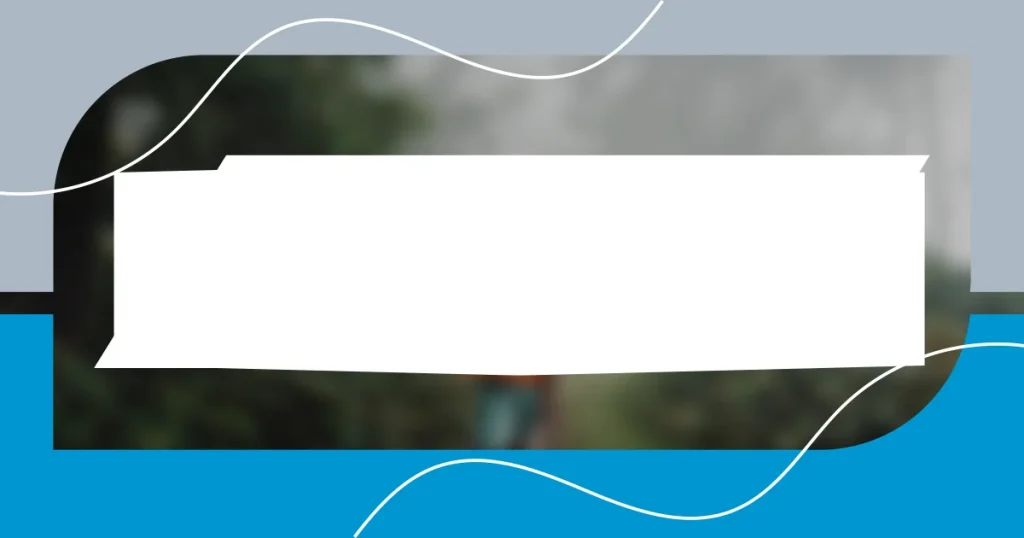Key takeaways:
- Remote monitoring empowers individuals to take control of their health by providing real-time data and fostering a proactive relationship with healthcare professionals.
- Utilizing tools such as wearable devices, mobile health apps, and telehealth platforms enhances the monitoring experience and creates collaboration in health management.
- Overcoming challenges like technical issues and data overwhelm is key to maintaining motivation and evaluating success through meaningful metrics and personalized goal-setting.

Understanding Remote Monitoring
Remote monitoring is all about using technology to keep an eye on things from a distance, and I find it fascinating how it transforms our daily lives. I remember when I first started using remote health monitoring devices; it felt like having a personal health assistant right at my fingertips. Have you ever thought about how empowering it is to track your health data in real time?
The beauty of remote monitoring lies in its ability to provide instant feedback and support. For instance, when my blood pressure monitor alerted me to an unusual reading, I was able to consult my doctor immediately. This capability brings a sense of security; it’s almost like having a safety net that catches you before you fall.
Moreover, I believe that understanding remote monitoring fully requires us to think about its implications. How does it change our relationship with health professionals or the way we manage our wellness? Seeing my doctor less frequently but still having access to ongoing data has reshaped my interaction with the healthcare system, fostering a more collaborative approach to my health journey. It prompts you to think: are we moving towards a more proactive model of healthcare?

Benefits of Remote Monitoring
One of the major benefits of remote monitoring is the flexibility it offers. I remember one time when I had a busy week ahead, packed with work and family commitments. With my remote monitoring setup, I was able to check in on my health without making special trips to a clinic. This convenient access allowed me to focus on my responsibilities while ensuring my health remained on track.
- Continuous Health Monitoring: I can monitor vital signs in real time without leaving home.
- Quick Access to Care: Immediate alerts for any concerning health changes mean I can act promptly.
- Increased Engagement: The data I collect empowers me to take control of my health decisions.
- Time and Cost Savings: By reducing unnecessary doctor visits, I save both time and healthcare costs.
- Personalization: The feedback I get helps tailor my health approach to my specific needs.
Remote monitoring also fosters a deeper connection with my health data. Reflecting on past experiences, I can honestly say that tracking my progress has been motivational. When I see improvements, it feels like I’m winning small battles, and each victory pushes me to strive for better health.
- Motivational Insights: Reviewing my health metrics has inspired lifestyle changes.
- Proactive Health Management: I’m more prepared to discuss my concerns with professionals.
- Greater Accountability: Knowing I’m being proactive keeps me committed to my health goals.
- Peace of Mind: I feel reassured knowing I can stay on top of my health from home.
- Community Support: Sharing my journey online connects me with others facing similar challenges.

Tools for Effective Remote Monitoring
Remote monitoring tools are pivotal for ensuring effective health management. My go-to is a smart wearable device that tracks my physical activity and sleep patterns. I recall once, during a particularly stressful deadline, my device alerted me to a decline in my sleep quality. This prompted me to take immediate action, prioritizing rest, and seeking ways to unwind, reinforcing how these tools can truly support our well-being even in chaotic moments.
In addition to wearables, I find that mobile health apps significantly amplify my remote monitoring experience. These apps allow me to log everything from daily meals to mood changes, which is invaluable for tracking patterns. I remember a week where I felt unusually fatigued. By analyzing my food intake and energy levels, I was able to identify a few less nutritious meals that coincided with my energy slump. This direct reflection made it easier for me to ask the right questions when consulting with my nutritionist.
Lastly, telehealth platforms have transformed my interactions with healthcare providers. I often think back to a virtual follow-up appointment I had. The seamless integration of my health data allowed me to discuss my concerns while having all relevant information at my fingertips. It felt almost collaborative – I was an active participant in my care rather than a passive recipient. These tools not only bridge distances but also create a sense of partnership that enhances my journey towards better health.
| Tool | Description |
|---|---|
| Wearable Devices | Track activity, sleep, and vital signs, providing real-time data for personal insights. |
| Mobile Health Apps | Enable food and mood tracking, offering a comprehensive look at lifestyle choices and their impacts. |
| Telehealth Platforms | Facilitate virtual consultations, creating a collaborative experience with healthcare professionals. |

Setting Up Remote Monitoring Systems
Setting up remote monitoring systems can feel overwhelming at first, but I’ve discovered that breaking it down into simple steps makes a world of difference. My experience starts with selecting the right devices—this isn’t just about functionality; it’s about comfort and wearability. I remember the first time I tried a bulky wristband. I barely made it through the day before I was itching to take it off. Finding something that fits seamlessly into your life is crucial for making remote monitoring effective and sustainable.
Once I’ve chosen my devices, I focus on the software integration. Connecting my wearable to a health app was a game changer. I recall one evening, logging into the app and discovering insights into my daily activity levels and sleep patterns. It was fascinating! Seeing the data visualized helped me adjust my evening routine, ensuring I prioritized better sleep to improve my overall well-being. It’s moments like these that make technology feel less like a chore and more like a supportive companion.
I’ve also learned that regular updates and calibrations are essential to keep everything running smoothly. I often take the time at the beginning of each month to check the device settings and ensure my health goals are still aligned. Reflecting on my journey, have you ever felt the satisfaction of seeing your progress laid out before you? There’s something incredibly empowering about that clarity, and it reinforces my commitment to the healthy habits I’m building with these monitoring systems.

Best Practices for Remote Monitoring
When it comes to remote monitoring, consistency is key. I’ve found that establishing a daily routine for checking in with my health data really pays off. For instance, I like to dedicate a few minutes each morning to review my stats from the previous day. It helps me start my day with intention, knowing exactly where I stand in terms of my goals. Have you ever noticed how a simple morning ritual can set the tone for your entire day?
Another best practice is to stay engaged with any support networks provided by your monitoring tools. I remember joining an online community associated with my health app. Sharing experiences and tips with others made me feel part of something bigger, almost like having a virtual workout buddy. There’s a sense of accountability that comes from interacting with people who are on similar health journeys, and it keeps me motivated. Do you have a support network in your health endeavors? If not, I highly recommend seeking one out.
Lastly, I cannot stress enough the power of adaptability in remote monitoring. Technology evolves, and so do our needs. I like to periodically review my goals and adjust my device settings to reflect any changes in my lifestyle. A great example was when I started running more regularly; I realized I needed a different set of metrics to track my progress effectively. Embracing change not only supports my health goals but also helps me stay excited about the journey. Are there aspects of your monitoring system you could tweak to better suit your current life? I find that those small adjustments can make a big difference.

Overcoming Challenges in Remote Monitoring
One of the primary challenges I faced in remote monitoring was the inevitable technical hiccups. I distinctly remember a day when my device stopped syncing with the app right before a big meeting. The panic was real! I learned to keep a troubleshooting guide handy and even reached out to customer support, which helped immensely. Now, I always perform a quick tech check before important events. It’s incredible how staying prepared gives me peace of mind.
Another challenge I encountered was dealing with the overwhelming amount of data. At first, I would get lost in the numbers and forget what was really important. However, I discovered that focusing on a few key metrics—like my daily steps and sleep quality—was far more effective than trying to track everything. I found it liberating to simplify my approach. Have you ever felt buried under your own data? I’ve learned to embrace the mantra: less is more when it comes to monitoring health.
Maintaining motivation can also be quite tough. There were days when I felt like throwing in the towel after a string of inconsistent results. I recall one particularly draining week when my activity levels plummeted, and I felt disheartened. But rather than giving up, I used that moment to reconnect with my “why” — the reasons I started my health journey in the first place. Reflecting on what truly drives me has been a game-changer. When was the last time you revisited the motivations behind your goals? Those moments of reflection can reignite your commitment and reshape your mindset.

Evaluating Remote Monitoring Success
Evaluating remote monitoring success goes beyond just numbers; it’s about understanding what those numbers signify in your daily life. I remember when I first started measuring my heart rate trends. Initially, I was obsessed with achieving lower numbers, but I soon realized that context matters more. Did my heart rate reflect my increased activity levels during workouts, or did it highlight stress or fatigue on a tough day? This shift helped me focus on the bigger picture, leading me to valuable insights about my health journey.
Also, the feedback loop plays a crucial role in this evaluation. I once participated in a monthly review with a health coach who helped me analyze my tracking data more thoroughly. It wasn’t just about the metrics; we discussed my feelings and lifestyle habits during that month. That experience opened my eyes to the emotional impact behind the numbers. How often do you sit down to really process your data and connect it to your personal experiences?
Finally, I believe that setting clear, realistic goals is essential for gauging success in remote monitoring. There was a time when I thought I should be running a certain distance every week. When it didn’t happen, I felt defeated. I learned to break my objectives into smaller, achievable milestones instead. For example, focusing on improving my pace started becoming a better measure of success than sheer distance. Have you ever felt similar pressure? Redefining success can transform your entire approach to remote monitoring, making it feel more rewarding and tailored to you.
















